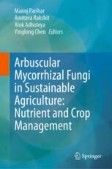Search
Search Results
-
Unraveling the diversity of hyphal explorative traits among Rhizophagus irregularis genotypes
Differences in functioning among various genotypes of arbuscular mycorrhizal (AM) fungi can determine their fitness under specific environmental...

-
Aphid infestation in the phyllosphere affects primary metabolic profiles in the arbuscular mycorrhizal hyphosphere
While effects of (a)biotic stress events in the phyllosphere have been studied intensively, possible influences of stress on the arbuscular...

-
Agronomic Practices for Optimizing the AMF Abundance and Diversity for Sustainable Food Production
The chapter emphasizes the critical role of arbuscular mycorrhizal fungi (AMF) in addressing soil fertility degradation caused by global climate...
-
Arbuscular Mycorrhizal Fungi Under Intercrop, Regenerative, and Conventional Agriculture Systems
Arbuscular mycorrhizal fungi (AMF) increase in diversity and abundance in agricultural systems that emphasize soil health practices, including...
-
Disentangling arbuscular mycorrhizal fungi and bacteria at the soil-root interface
Arbuscular mycorrhizal fungi (AMF) are essential components of the plant root mycobiome and are found in approximately 80% of land plants. As...

-
A tripartite bacterial-fungal-plant symbiosis in the mycorrhiza-shaped microbiome drives plant growth and mycorrhization
BackgroundPlant microbiomes play crucial roles in nutrient cycling and plant growth, and are shaped by a complex interplay between plants, microbes,...

-
Bacterial diversity among the fruit bodies of ectomycorrhizal and saprophytic fungi and their corresponding hyphosphere soils
Macro-fungi play important roles in the soil elemental cycle in terrestrial ecosystems. Many researchers have focused on the interactions between...

-
Short-Term Evaluation of the Spatial Distribution of Trophic Groups of Amoebae in the Rhizosphere of Zea mays Inoculated with Rhizophagus intraradices
Primary production in terrestrial ecosystems is sustained by plants, microbiota, and fungi, which are the major organic matter providers in the root...

-
Extraradical Mycorrhizal Hyphae Promote Soil Carbon Sequestration through Difficultly Extractable Glomalin-Related Soil Protein in Response to Soil Water Stress
Soil water stress (WS) affects the decomposition of soil organic carbon (SOC) and carbon (C) emissions. Glomalin, released by arbuscular mycorrhizal...

-
Role of Arbuscular Mycorrhizal Fungi in Nitrogen and Phosphorus Cycling Within Terrestrial Ecosystems
Symbiosis of plants with arbuscular mycorrhizal (AM) fungi is arguably the most widespread inter-kingdom association in terrestrial ecosystems,...
-
Harnessing plant–microbe interactions to promote nitrogen use efficiency in cereal crops
BackgroundIncreasing nitrogen (N) use efficiency (NUE) can enhance cereal yields, improve grain quality and reduce agrochemical inputs. However,...

-
Root Exudates and Their Importance in Arbuscular Mycorrhizal Symbiosis and Nutrients Navigation from Inaccessible Soil: An Efficient Mediator of Mineral Acquisition in Nutrient Deprived Soil
The growth and development of plants happen through internal molecular communications that rely on adequate nutrient supplements to roots from the...
-
Mycelial nutrient transfer promotes bacterial co-metabolic organochlorine pesticide degradation in nutrient-deprived environments
Biotransformation of soil organochlorine pesticides (OCP) is often impeded by a lack of nutrients relevant for bacterial growth and/or co-metabolic...

-
Synergistic Effects of Arbuscular Mycorrhizal Fungi and PGPR on Yield Improvements in Millets
The contribution of soil microflora in maintenance of soil fertility and plant health is significant. The mycorrhizal fungi are one of the key...
-
Soil microbial community response to ectomycorrhizal dominance in diverse neotropical montane forests
Ectomycorrhizal (EM) associations can promote the dominance of tree species in otherwise diverse tropical forests. These EM associations between...

-
Does arbuscular mycorrhizal fungi inoculation influence soil carbon sequestration?
Whether arbuscular mycorrhizal fungi (AMF) inoculation promotes soil C sequestration is largely unknown. Here, meta-analysis and logistic regression...

-
Mushroom Metagenome: Tool to Unravel Interaction Network of Plant, Mycorrhiza, and Bacteria
In a world of scientific breakthroughs, the solution to our most pressing problems could be right under our noses – microbes. The rhizospheric...
-
An arbuscular mycorrhizal fungus alters soil water retention and hydraulic conductivity in a soil texture specific way
Arbuscular mycorrhizal fungi (AMF) alter plant water relations and contribute to soil structure. Although soil hydraulic properties depend on soil...

-
Analysis of the influence of phytate-P on shoot and root traits in mycorrhizal-enhanced wheat varieties
AimsPhytate is the most abundant form of organic phosphorus (P) in soil. The plasticity of plants changes in response to various environmental...

-
Mutualistic interaction of native Serratia marcescens UENF-22GI with Trichoderma longibrachiatum UENF-F476 boosting seedling growth of tomato and papaya
A plethora of bacteria–fungal interactions occur on the extended fungal hyphae network in soil. The mycosphere of saprophytic fungi can serve as a...

